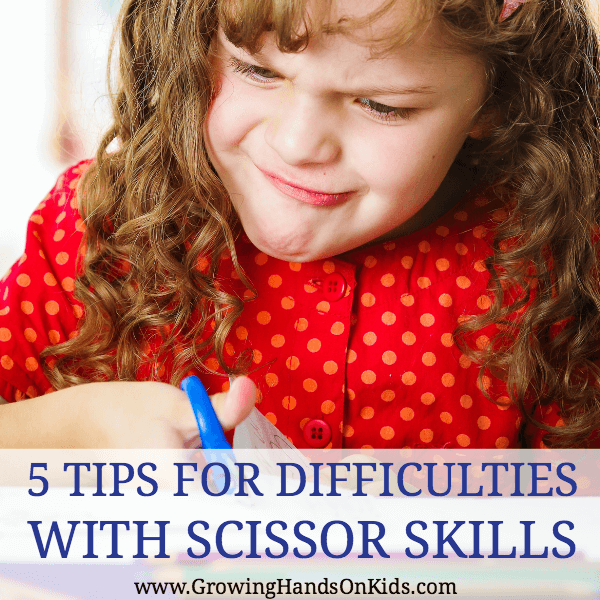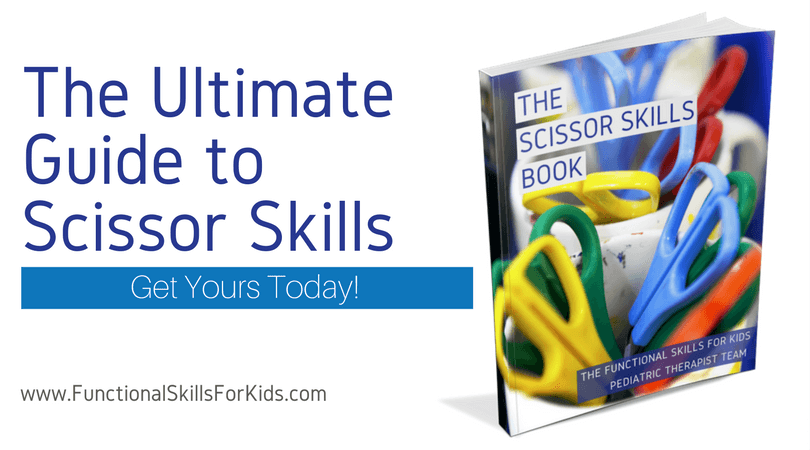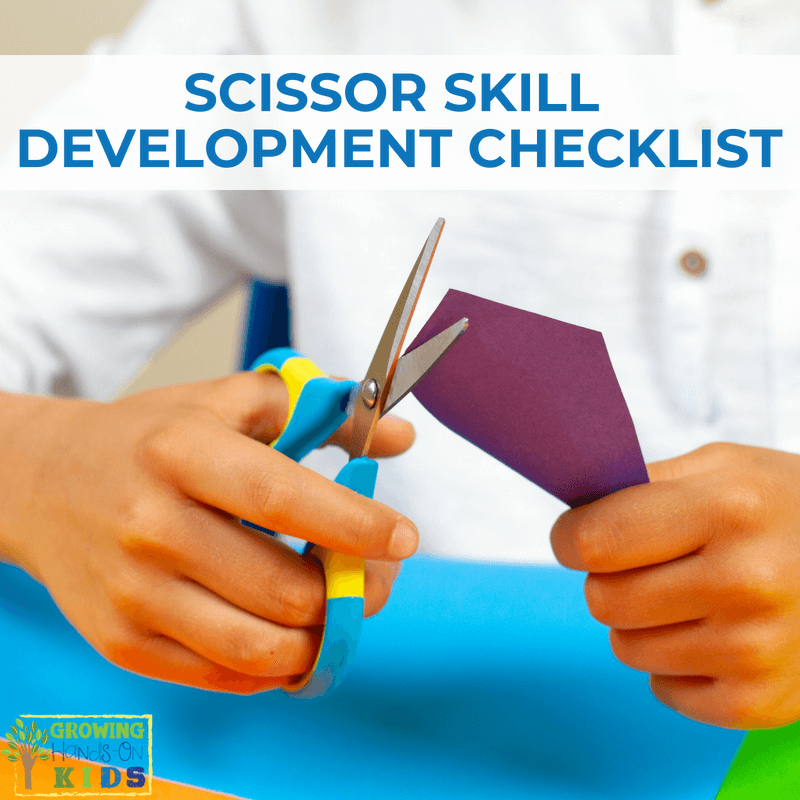5 Tips for Difficulties with Scissor Skills for Kids
Affiliate and Referral links are used below to promote products I love and recommend. I receive a commission on any purchases made through these links. Please see my disclosure policy for more details. As an Amazon Associate, I earn from qualifying purchases.
You've read how important scissor skills are, but your child seems to struggle with this skill. Whether they are in preschool, kindergarten, or elementary age there are some strategies you can try to help them master this skill. Today as part of the Functional Skills for Kids series, we're going to look at some of these ideas.
Table of contents
Here are 5 tips to help you problem-solve your child's difficulty with scissor skills.
Tip #1 – Do a “task analysis” to figure out the exact problem
This is a therapy technical term, but it is important for parents and teachers to understand too. When a therapist looks at difficulties a child is having, they do a task analysis to pinpoint exactly where the child or client is having a problem.
Here are some questions to help you figure this out:
- Is your child having problems holding the scissors? (They could be left-handed, or have fine motor weakness, or bilateral coordination difficulties)
- Do they have problems managing the paper and scissors together? This could specifically be a bilateral coordination problem; using both sides of the body together, and also a proprioception problem; being able to move and use muscles for skill without necessarily looking at their hand or arm while moving it.
- Do they have problems keeping the scissors on the cutting line? This could be a control issue with the scissors, going back to fine motor skills, OR a visual motor problem.
Tip #2 – Holding the Scissors (Plus Left Handed Tips!)
Many children can improve their scissor skills and cutting skills with practice. Sometimes they just need more exposure to use them and can pick up on the skill really quickly. If this is the case, I've got a free scissor practice packet that can help your kids catch up on this skill.
If you have a child that is left-handed, be sure you have scissors that are made for left-handed kiddos. You wouldn't think this would be a major issue, but it is. When a child uses right-handed scissors, it forces them to hold the scissor in a clumsy manner which affects their cutting. Here is a great resource from OT Mom explaining why left-handers should use left-handed scissors.
Some children need some extra support with grasping scissors and have trouble with the open/close movement. There are a lot of adaptive scissor options that can help assist with them holding the scissors. I have had good success using a gift wrap cutter with many kids. Here are also some other options for scissors that can help.
Tip #3 – Managing Paper and Scissors Together
Being able to hold the paper and scissors together is part of bilateral coordination, using both sides of the body together. When a child holds the paper and scissors, both thumbs should be facing up. Many children have problems keeping both thumbs up and then coordinating the movement to be able to rotate the paper and cut on the line. It is a very complex skill when you break it down step by step.
Working on bilateral coordination skills is a great first step. Your child may also need a visual cue for the “thumbs up” position. Taking a picture and placing it on their work surface provides a great visual reminder. I've also put small stickers on the fingernail of each thumb (smiley faces work especially well) and tell the child to keep their thumbs up so they can see the stickers.
Another tool I have used with children who were only able to use one hand is a tabletop scissor with a base. It does require an adult to hold the paper, but the child is able to use the scissors with one hand and not worry about the paper. This is helpful for children who have had strokes, CP, TBIs, etc.
Tip # 4 – Keeping the Scissors on the Cutting Line
Keeping the scissors on the line is a visual perception and tracking skill. I have found that highlighting the cutting line with a yellow or light blue marker can help give an extra visual cue for children to keep the scissors on the line.
Some children may also be trying to cut too quickly. Using thicker paper, such as stock paper or construction paper can help them control the movements.
Working on some visual-motor skills such as catching a ball, connecting the dots, lacing cards and other visual-motor activities can be very helpful for strengthening that skill as well.
Tip #5 – Practice Cutting With Items Other Than Paper
Practicing with items such as play dough, clay, or foam boards is a great way to practice scissor skills with items other than just paper. Making a collage out of magazines for an art project, or a paper plate cutting craft is a great way to practice cutting skills during a functional task.
Also, remember using kitchen scissors for meal prep is a great practical skill and especially helpful for children who may have trouble using a knife or be a little bit safer for younger children who have difficulty using knives.
Looking for more tips on scissors skills? Check out The Scissor Skills Book, written by the Functional Skills for Kids pediatric therapist blogger team.
The Scissor Skills Book breaks the functional skill of cutting with scissors into several developmental areas including:
-developmental progression of scissor use
-fine motor skill involvement
-gross motor development
-sensory considerations and
-visual perceptual skills
And each section includes strategies and tips to improve these underlying areas:
- Help kids who struggle with cutting accurately
- Creative tips to keep things interesting for kids who lose interest easily
- Ideas for kids who cut too fast or too slow
- Quick, practical strategies that can be put into action today!
You May Also Like:

Heather Greutman, COTA
Heather Greutman is a Certified Occupational Therapy Assistant with experience in school-based OT services for preschool through high school. She uses her background to share child development tips, tools, and strategies for parents, educators, and therapists. She is the author of many ebooks including The Basics of Fine Motor Skills, and Basics of Pre-Writing Skills, and co-author of Sensory Processing Explained: A Handbook for Parents and Educators.





Practice makes perfect. I totally agree with you on keeping the scissors on the cutting line as my 3 year old son can now cut circle with ease. Always use a safety scissors!
I always have the beginners start cutting while standing up, they have better control and have fewer problems. Usually the table heights are not at the right height for cutting .
Great point!
#5 is a great idea! My son is reaching the age of being ready to use scissors and using play dough to practice is on is brilliant!
Lol! I can relate, thanks for the tips. 🙂
These are great tips! I love how you provided pictures of all the different kinds of adapted scissors that are available – there are so many options that teachers and parents don’t know about!